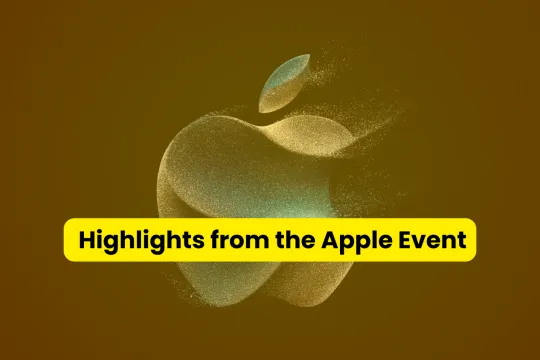Apple's most recent flagship device, the iPhone 15, made its debut on September 12, 2023. This innovative smartphone boasts a range of advancements and enhancements in comparison to its predecessor, the iPhone 14, launched a year prior. However, is it worth upgrading from the iPhone 14 to the iPhone 15? What distinguishes these two models from one another? TheGeekyThings aims to address these inquiries by examining the key features of both smartphones.

Design and Display Features
On the outside, the iPhone 15 doesn't appear to have changed much when compared to its predecessor, the iPhone 14. Both models have a 6.1-inch display for the standard and Pro versions and a 6.7-inch display for the Plus and Pro Max versions. Their designs are also quite similar, featuring flat edges and curved corners. Nonetheless, there are several significant distinctions worth mentioning.
One notable feature of the iPhone 15 is Dynamic Island, a small rectangular area situated at the top of the screen. This display provides users with quick access to vital data, such as the time, date, battery level, network connectivity, messages, and more. The Dynamic Island even offers real-time updates, like heart rate, step count, and weather conditions.
Another key improvement involves the replacement of the Lightning port with a more versatile USB-C port. USB-C port enables faster charging and data transfer capabilities for the device.
The iPhone 15's OLED screen is also a step above its predecessor, boasting a brightness level of up to 2000 nits, twice what the iPhone 14 could manage. Consequently, the display is more easily viewable under bright sunlight or in dark conditions.
Lastly, the iPhone 15 color availability slightly differs from its predecessor, offering five color options: pink, yellow, green, blue, and black, compared to the six options available for the iPhone 14.
Camera in Smartphones
The significance of camera features in smartphones cannot be overstated, particularly for individuals who enjoy capturing images and recording videos. A notable enhancement in this aspect is observed when comparing the latest smartphone model with its predecessor.

The newer model boasts a cutting-edge 48-megapixel primary sensor for all variants, ensuring highly detailed and clear photographs. This updated smartphone model also incorporates a 12-megapixel front-facing sensor for all versions. Consequently, users can achieve exceptional portraits and engage in high-definition video calls.
The advanced versions of this smartphone, namely the Pro and Pro Max, come equipped with an additional lens, specifically the telephoto lens. The Pro model incorporates a 12-megapixel sensor with 3x optical zoom capabilities, ensuring clarity when zooming in on subjects. Alternatively, the Pro Max model features a 12-megapixel sensor with 5x periscope zoom, facilitating an even closer and more detailed view of objects.
Indeed, the advanced models of the iPhone 15 come with several distinct camera enhancements. Both variants now can capture images at multiple focal lengths (24 mm, 28 mm, and 35 mm), while the iPhone 15 Pro Max is equipped with an innovative "tetra prism" telephoto lens, providing up to 5x zoom and up to 120 mm focal length.
Apple asserts that this camera requires more room than the iPhone 15 Pro can accommodate, resulting in its exclusive availability on the top-tier iPhone 15 Pro Max.
Furthermore, several software-based advancements are offered to both Pro models, which are not found in their more affordable counterparts. These include a cutting-edge Photonic Engine for enhanced low-light photography and the support of the powerful A17 Pro chip integrated into the new Pro iPhone line.
So, in terms of cameras, the iPhone 15 reached a new height compared to its predecessor, which also had amazing shooting capabilities.
Processor and Storage
The iPhone 15 showcases Apple's latest A16 Bionic chipset, which holds the title for being the quickest and most robust smartphone processor currently. This powerful processor boasts six cores, comprised of two high-performance and four energy-efficient ones. The A16 integrates an Apple-designed five-core GPU, which is reportedly coupled with 50% more memory bandwidth when compared to the A15 GPU. These features enable the iPhone 15 to run all games and applications seamlessly, without any lags or glitches. Furthermore, the A16 Bionic processor enhances the capabilities of the device's cameras, artificial intelligence, augmented reality, and other functions.
In terms of storage, the iPhone 15 is similar to its predecessor, the iPhone 14. The standard version of the iPhone 15 offers 128 GB of storage, just like the iPhone 14. The iPhone 15 Pro Max comes with 256 GB of internal storage, as opposed to 128 GB in the iPhone 14 Pro Max. Both models also have the option of choosing between 512 GB and 1 TB of storage.
Battery Life
Apple's newest release, the iPhone 15, boasts a more expansive battery capacity compared to its predecessor, the iPhone 14. Entry-level iPhone 15 models feature a 3349 mAh battery, a significant upgrade from the meager 3279 mAh found in the iPhone 14. Additionally, the iPhone 15 Pro Max is packed with a 4422 mAh battery, outshining the iPhone 14 Pro Max 4323 mAh

As it was announced at the Apple Event 2023, the iPhone 15 will hold a charge throughout the day. However, comparisons on the manufacturer's website show that the performance compared to the iPhone 14 has not changed.
Is it worth changing?
So, almost a week has passed since the sales start of the iPhone 15, and many people are wondering whether to replace the previous model with a new one. The iPhone 15 in the lower segment has improved features such as the camera, Dynamic Island, etc. It also now has more convenient charging and fast data transfer with USB-C. That is, it is closer to the flagships of its family than the iPhone 14. If you need high-quality photos and videos, high performance, and a sense of modernity, then yes.
Source: Apple
More Apple News
News iPhone 15 Before the Sales Start. What Was Discovered After the Release
Get the scoop on the all-new iPhone 15 and iPhone 15 Pro! Uncover exclusive details from Apple features before they hit stores with TheGeekyThings. Be the first to know.
New iPhone 15 with USB-C, and New Apple Watch. Highlights from the Apple Event.
Find out all the details about the new iPhone 15, iPhone 15 Pro & Apple Watch from Apple's big event. Stay informed of all updates to be ready for their launch with TheGeekyThings team.
Detail-oriented editor aiming for excellence. I keep up with web dev, gaming, and tech trends in my free time and write about




